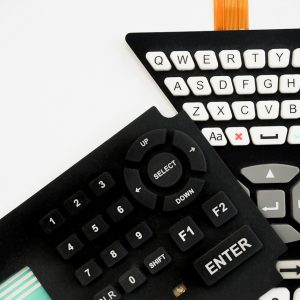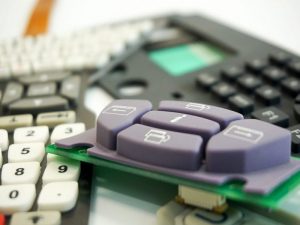Silicone rubber keypads are user interface components that provide functionality and design to finished products. Silicone rubber keypads are like the buttons on your TV remote. They are commonly used in consumer products, industrial controls, and medical devices. Silicone rubber keypads can be customized to your unique application, but here are some common features to help you decide if they're the right component for your product.

-
Water and Chemical Resistance
Silicone rubber keypads are designed to withstand harsh environments. This makes them ideal for use in industrial control panels, construction, consumer goods, and many handheld devices. In the construction industry, for example, user interface controls on heavy machinery and other tools can be exposed to sunlight and extreme weather conditions. The water resistance of silicone rubber keypads makes them a great option for the construction industry.
Silicone rubber keypads' ability to resist water and chemicals also makes them ideal for hospital settings where machines are constantly sprayed down and sanitized with chemicals. When fluids or chemicals come into contact with your keypad, you can rest easy knowing that the product’s functionality will remain the same no matter what they may be exposed to.
-
Tactile Buttons
Silicone rubber keypads are a combination of buttons that provide a tactile response when pushed. Each button serves a different purpose and can control different aspects of your product.
The tactile feel makes it possible for the end user to feel the button clicking as pressure is applied and released, even if the end user is wearing a pair of gloves. This is commonly known as tactile feedback because the clicking of the metal dome found inside of each button allows them to know that the button is working properly. Because silicone rubber keypad buttons provide tactile feedback, they offer peace of mind for the user operating the product or controls. The travel, actuation force, and audible click can be adjusted for each unique application.
Keypads can be designed to have either rubber or plastic injection molded buttons. Your choice of button depends on the end-use of the product and the aesthetic required. Rubber buttons provide a soft touch and feel. Hard plastic keycaps are rigid and allow for a decorative look. Keycaps can be molded with designs, images, and shapes that can’t be achieved with rubber alone. Plastic keycaps can also be molded clear to allow light to shine through. This is a great feature when considering low-light conditions or when high visibility is required.

-
Printed Circuit Board (PCB)
The circuit layer of a silicone rubber keypad is the electrical system that allows the device to function. You can think of the circuit layer as the brains within your product. These circuit layers are typically copper flex circuits but also can be manufactured using a rigid Printed Circuit Board, commonly known as a PCB for short.
Within silicone rubber keypads, there is an inert layer that prevents the buttons from functioning until pressure is applied. Once pressure is applied, the circuit within the layer is complete, allowing the keypad to function as needed. As pressure is removed from the button, the circuitry will be incomplete, and the functionality of the button pressed will no longer be activated.
-
Backlighting
By incorporating backlighting into your product’s design, the keypad icons can be illuminated, making each button’s functionality known no matter the user's setting. Because of their variable use across several industries, it is no surprise that some keypads may need a lighting element implemented so that the product can be seen in low-light situations.
In a construction setting, for example, sometimes workers have to work late into the night so providing tools with backlit controls is essential to their safety.
Ready to Customize Your Product?
Silicone rubber keypads provide durability by withstanding moisture, chemicals, and harsh weather conditions. They can also provide a sense of safety because they provide tactile feedback when a button is pushed.If you're ready to incorporate silicone rubber keypads into your next product, reach out! We’ll be happy to help!